At the start of this year, I got diagnosed with type 2 diabetes. It's the kind of diabetes you get if you live in the West, eat too much and don't exercise enough. It means that I have too much glucose in my blood and my insulin isn't able to convert enough of it into energy my cells can use. I have to admit, it wasn't a surprise. I knew I was overweight, and had had conversations before with doctors about being pre-diabetic. This time was different. My blood sugar level wasn't merely pre-diabetic. This time, my doctor told me in no uncertain terms that I was going to be injecting myself with insulin in the future. The Rubicon had been crossed.
A blood test in late December 2011 had established my HbA1c at 12.2. Your HbA1c is a long-term measure of blood sugar. At 5.7 to 6.4, your diagnosis is pre-diabetic. Above 6.5, you're diabetic. I left the clinic upset and angry. I didn't want to accept the medical prognosis. I didn't want to inject myself with insulin forever. I didn't want to go blind and I didn't want to lose my feet, both stereotypical long-term diabetic outcomes.
But I saw that I was faced with a body that was in bad shape because of the "software" that was running on its brain. There is a movement — at the moment a weak signal among "alpha geeks" predisposed to obsessive tendencies — preoccupied with measuring and quantifying the self. The idea itself isn't new: notice and measure things about your "software" and your "hardware" and then try to affect them. But as ever, technology trickles down to the consumer and makes what used to be difficult easy, and what was once obscure accessible.
Perhaps not coincidentally, the first generation to have built their careers on the Internet is slouching towards middle age. The market is now full of smart, wearable devices that passively observe, record and communicate your daily activity and even the quality of your sleep. Shoes will "talk back to you", telling you how far you've run or how high you've jumped. Scales wirelessly communicate your weight. On the receiving end, easy tools record the things that can't yet be passively measured, like the kind of food you're eating or your mood. The theory goes: if you have the data, you can experiment with the outcome. This so-called "personal informatics" movement is what happens when Moore's law collides with publishing's "self-help" category. The promise of this movement is nothing less than minimal-effort self-improvement; of the language of A–B testing, always in beta, perpetual optimisation and analytics, but applied to the body and mind, to yourself.
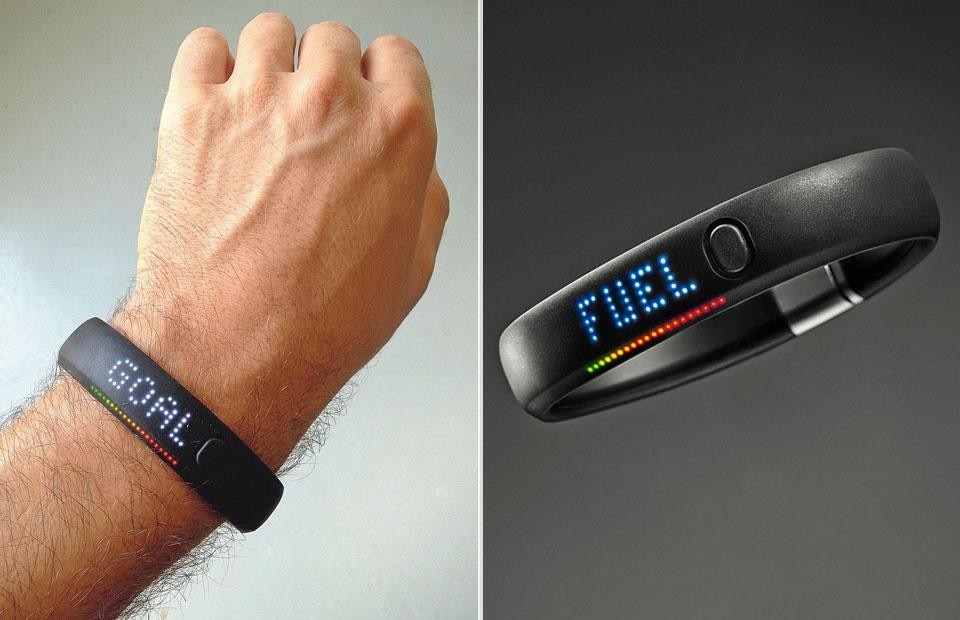
So a few things happened. I got a Lifescan OneTouch UltraMini — a blood glucose meter — and started measuring my blood sugar first thing in the morning, and before and after each meal. I bought third-party software — Glooko — so I could liberate the data held in my blood sugar meter. I got a Withings scale that uploaded my daily weigh-in to the cloud. And I got a Nike FuelBand and a Fitbit — two devices that I wear all day and that silently watch over me to make sure I'm moving enough. Six months later, my HbA1c is at 5.4: comfortably inside the normal, healthy range. From one perspective I had a major reality check from a medical professional, delivered in an uncompromising manner. On the other hand, a suite of services and devices I assembled helped me become aware of my behaviour and then change it. Effectively, I'd healed myself through data.

An obesity epidemic now faces most Western countries. In the US, an over-medicated and increasingly hefty population faces a woefully inadequate, expensive and fragmented healthcare marketplace. In European countries, welfare states buckle under the strain of an ageing population hitting them with a left-right combination of a diminished tax base and increased demands on healthcare, with growing obesity a major problem across the continent.
The human race is essentially getting larger and unhealthier. Because of that, this generation of children is the first in recorded history to have a shorter life expectancy than their parents. Although simplistic, we know that the answer lies in eating healthier food and doing more exercise. Although there are signs that some governments are taking notice of the potential in "nudging" behaviour, few dare get into the business of explicitly telling people what to do. So the fact that people can take better care of themselves through positive behavioural change, supported by simple inexpensive devices giving supportive nudges, is incredibly encouraging.
We don’t yet know much about the psychological or cultural impact of learning so much about ourselves through the prism of performance metrics
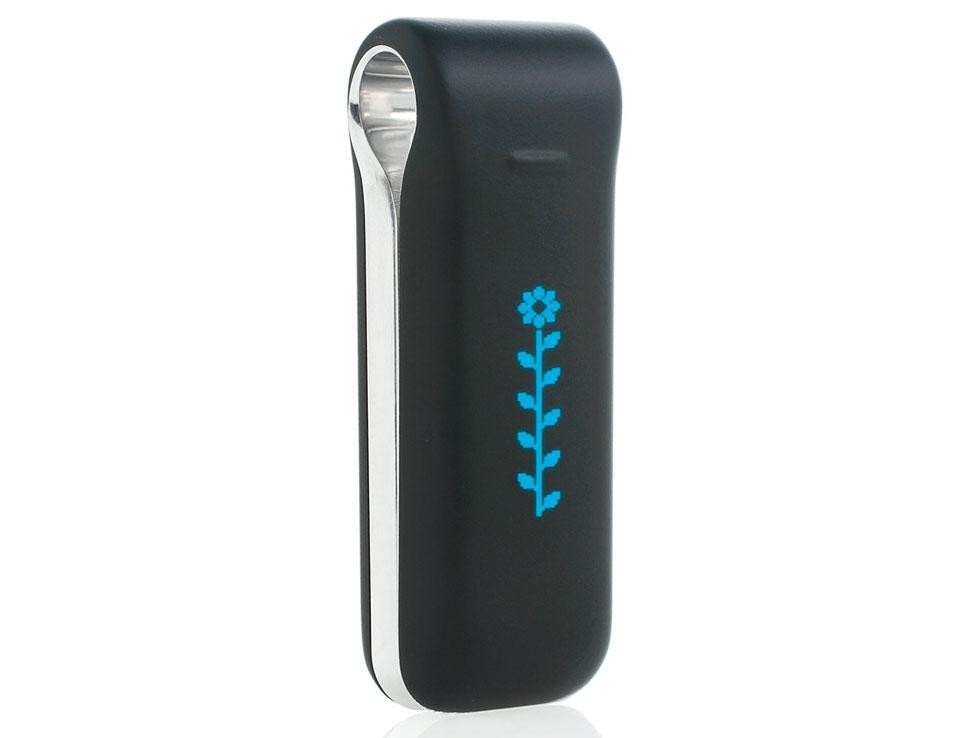
The last six months have given me a deep, visceral insight into what it means to experiment with personal informatics. In a word, the best way to describe how this explosion of health data works is "messily". Let me count the ways my health is now looked after. At the professional end, an electronic health record (EHR) is held by my primary care provide and my insurer. My clinic has rolled out access to my EHR through software called MyChart, but I can't get access to it because they appear to have the wrong social security number on file, but it promises the ability to view test results, schedule appointments and refill prescriptions, among other things. The consumer-accessible version of my data is split between a service run by WebMD and my insurer, Cigna, one of the largest in the United States. At the amateur consumer-of-health end, I have my own devices and software, each living in their own ecosystem and producing their own, somewhat overlapping, circles of interoperability. My scales will tell everything else: how much I weigh, my body mass index (BMI) and my fat percentage. They talk to the Fitbit web service (though Fitbit don't make it easy) and Budge, a service that sends me a daily email reminding me of my weight. It seems the strategy of Withings is to be a producer, not consumer or aggregator, of data.
The movement-related devices and services are trickier. Nike's Nike+ Running is a silo, as is their FuelBand: data enters from a device or application and stays there; there appears to be no way to either import or export data from their services. It's possible to imagine a universe where Nike's devices and services work with each other in a harmonious, well designed, walled garden. Fitbit, though, is quite ready to upsell a service that allows its subscribers to keep track of more data. Their strategy is to be the one-stop shop storing my personal health-related data, from blood sugar to food intake, from steps climbed to my heart rate, blood pressure and mood. To combat this Balkanisation of health data, RunKeeper, a physical activity tracker, announced an open Health Graph in June last year.
As it stands, my health data is all over the place. Some of it is in a Nike silo. Most of it is in either EHRs (to which I have some access), or a vault run by WebMD, because my insurer has made a deal with them instead of Microsoft Healthvault (Google is nowhere to be seen: Google Health was retired in late 2011). While my diabetes data is downloaded over USB into software produced by the meter manufacturer, it is then examined by my doctors and typed back in to my EHR. They wouldn't know what to do with my FuelBand or Fitbit data.
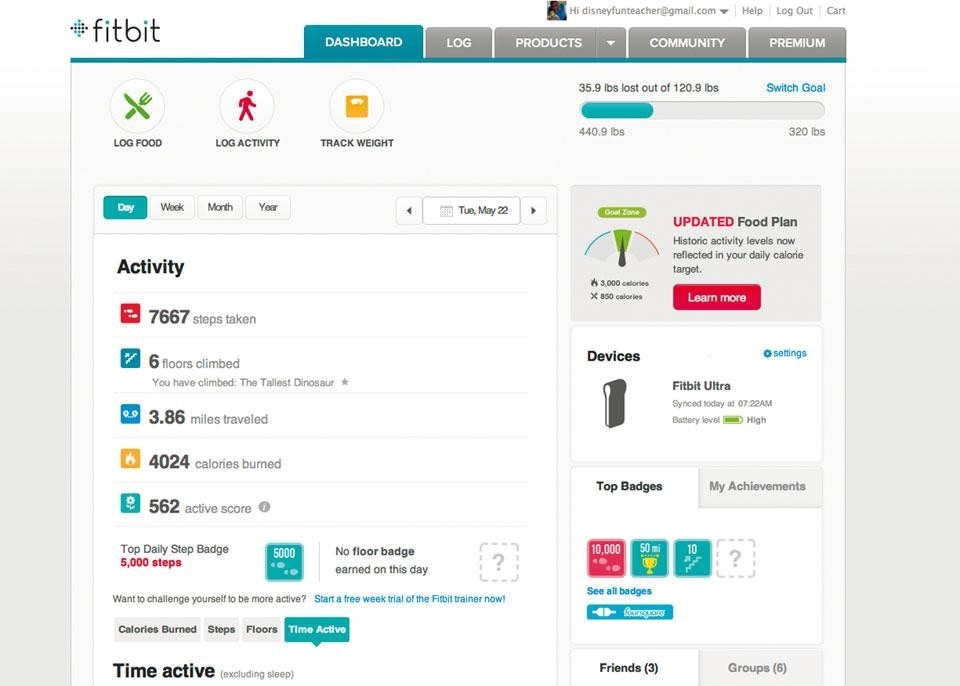
This messiness is problematic. The "gamification" that many contemporary web services look to exploit relies on broadly consistent tracking and sharing. But if personal informatics is at the beginning of its uptake-curve, so is the application of these game mechanics to our social lives: the typical methodology at the moment involves measuring, awarding points and then levelling up to (generally meaningless) badges when some sort of milestone is reached. Yet I, and many others, am some kind of proof that such approaches can work. If these techniques scale across a wider population (no pun intended) can this combination of real-time feedback and positive peer-group pressure begin to rein in the obesity epidemic? There are at least two obvious stumbling blocks: consistency and fatigue. When it comes to physical exercise, every scrap of data feels important. It is distressing when a run "doesn't count", or counts only in one silo. I know I ran today, but my services say I didn't. Now my 23 days in a row are back to zero. A single syncing error can be psychologically off-putting, and mortally wound the potential of gamification. Motivation needs all the help it can get.
Then there is the suspicion that while these gamification methods work, they won't work for very long and "badge fatigue" will set in. At which point the problem becomes rather more interesting — if you're in the business of selling numbers to track, how do you get me to care about this number instead of that? When it comes down to it, Fitbit, Nike and RunKeeper will all pretty much be tracking the same thing. There are only so many ways in which one can weigh one's self and track one's movement. There is a tension at the core of all this. Given that it all relates to my body and my motivations, interoperability is necessary to coherently track, share and bring together all my data, centred on the self. Yet newly emergent and competing services also have to differentiate themselves from each other, to move apart as they jostle for space, looking for a productive niche.
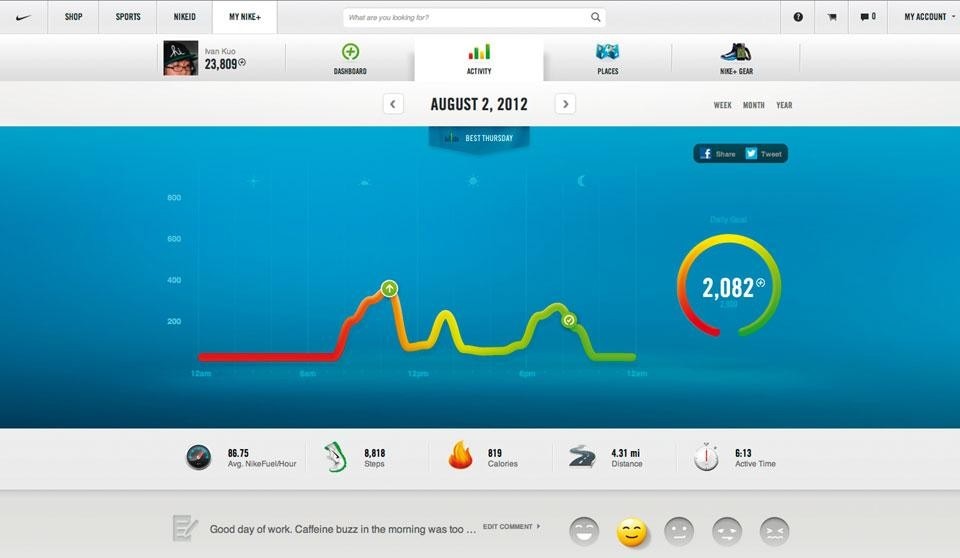
As such, the business of differentiation becomes another illustration of the philosophies behind these new companies: those that are ecosystem and service-driven (Fitbit, RunKeeper and Withings) and those that are, due to an accident of history, atom-based (Nike). It turns out that this is also played out in industrial design. Companies like Fitbit and RunKeeper betray an engineering-led Silicon Valley aesthetic of utility for utility's sake and are, for lack of a better term, services. They are not "fun", and at worst difficult to use. They do not mean anything other than to provide you with value. A Fitbit falls over backwards to offer you features, settings, preferences and customisation options. With its altimeter, three-axis accelerometer and wireless syncing system, Fitbit is in some technical respects better than Nike's FuelBand. Simply, it tracks more; it exemplifies services designed for someone who flicks through Men's Health while they browse Gizmodo.
A few hours up the US west coast though, lies a company built upon not just sport performance, but also personal expression, fashion and style. Nike's FuelBand is worn around your wrist. It looks and feels better, with its black rubber and distinctive pinpricked colour display inviting discussion. There are limited edition designs, like the translucent FuelBand ice, betraying a company steeped in diffusion lines and brand extensions. In comparison, the Fitbit is discreetly clipped (Dilbert-style) to the belt, or pocketed and hidden from view. FuelBand has just one button to cycle through its "Fuel" metric, time, calories and steps. Though it is a silent device that constantly logs your activity, it is not out of sight — it is permanently visible, a wearable statement. You're not given the choice of hiding it. While it may be passive, you are constantly reminded of its presence, invited to press the button to see your score and, upon reaching your goal, rewarded with the dopamine of a multicoloured achievement animation.
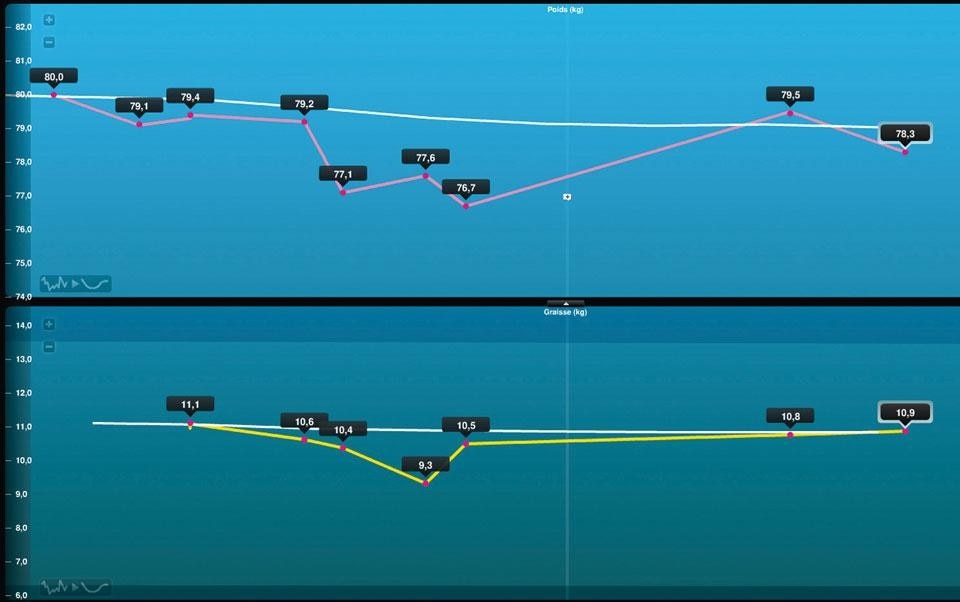
Though Fitbit and FuelBand are mass-market products here and now, they really ask questions of the near future. For this is a rewarding but frustrating time. For those who have the patience — or, in my case, the pressing need — it's possible to cobble together some sort of functional personal informatics platform. In the future, these devices and services should interoperate with each other better, but it's clear that today we are at the beginning: the hardware devices are only in their first or second iterations as pieces of mass-produced technology, and most of the cloud services are less than a few years old.
However, the majority of lower-level foundations are in place: battery hardware, display technology, low-energy wireless communication and sensor platforms are now commonplace, and it is easier than ever to deploy web services that can scale to meet demand when users begin to find each other.
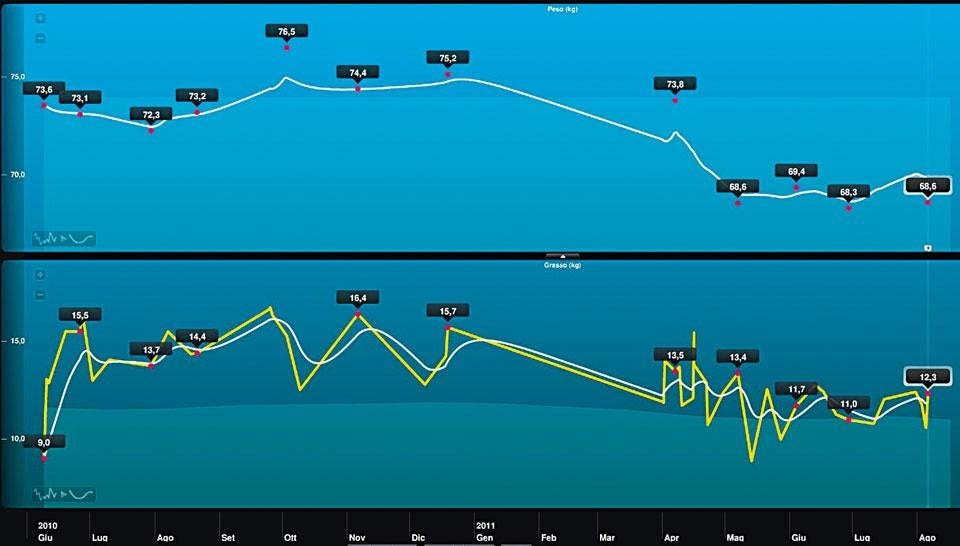
Yet we don't know much about the psychological or cultural impact of learning so much about ourselves, of seeing ourselves through the prism of performance metrics, never mind displaying that in a public form. This is perhaps the most intriguing aspect of personal informatics: it lets us know who we really are, whether we wanted it to or not. Dan Hon (@hondanhon), interactive creative director at Wieden+Kennedy. Among the many projects he has worked on is a campaign for Nike's FuelBand, discussed in this article
The images in this article are taken from Databetic, the blog created by Doug Kanter to keep a public record of data regarding his condition as a diabetic and track the pathology's development over time.


